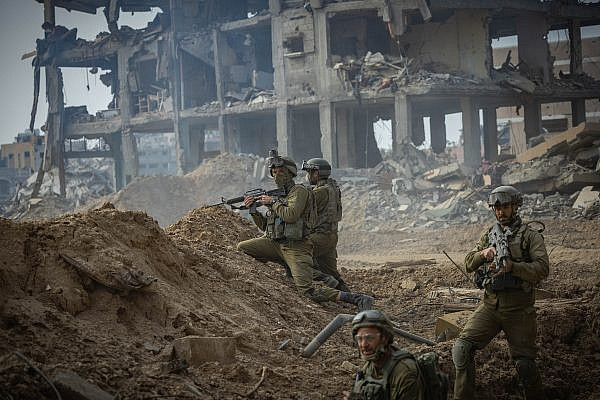It’s been a long time since we’ve seen news coverage as shallow as the Israeli media’s coverage of the pro-Palestine demonstrations on college campuses across the United States in recent days.
In a segment that aired on April 24, for example, Channel 12’s Yuna Leibzon showed footage of the protests outside Columbia University’s campus: viewers saw a handful of people chanting that Tel Aviv should be burned to the ground, and a lone masked protester holding a sign bearing an antisemitic statement. The implication was clear: these individuals are representative of all the protesters, and the entire pro-Palestine movement is illegitimate.
Neria Kraus, Channel 13’s correspondent in New York, also reported from Columbia’s campus. In her coverage, she used three terms interchangeably: “pro-Palestinian demonstrations,” “anti-Israel demonstrations,” and “antisemitic demonstrations.” The message, again, was clear: to be pro-Palestinian or anti-Israel is to be antisemitic.
When Gil Tamri, a senior commentator at Channel 13, went on to explain to presenter Udi Segal that these were not antisemitic demonstrations but anti-Israel demonstrations, Tamri was cut off mid-sentence and Segal moved on to talk about Congress’ approval of a package of U.S. military aid to Israel. On Raviv Drucker’s daily talk show “War Zone,” also on Channel 13, Professor Rivka Carmi, the former president of Ben-Gurion University, also framed the protests as “antisemitic” — again, without providing any context.
The conflation of these distinct concepts creates a sense among Israelis that Jews are being widely persecuted in New York City. It suggests that the Israeli news correspondents standing at the entrance of the Manhattan campus are on an information-gathering mission of national importance, reporting from behind enemy lines and peering into the depraved core of anti-Jewish hate.

This is the same media ecosystem that, for nearly seven months, has utterly neglected its most basic duty to show viewers, listeners, and readers in Israel what their military is doing to Palestinians in Gaza. Only those Israelis who choose to consume foreign media understand that the student-led protests are indicative of a huge and rapidly proliferating wave of demonstrations in solidarity with Palestinians and against Israel and Israeli policy in Gaza, not an inexplicable outburst of antisemitism.
These two trends — the Israeli media’s unbending self-censorship in its coverage of the devastation in Gaza, and its framing of the pro-Palestinian demonstrations in the U.S. as antisemitic — are closely linked. Simply put, those who are not aware of what Israel is doing in Gaza cannot understand the reaction of those who are.
With the exception of Haaretz readers, and a small number of others who engage with niche independent news sites, the vast majority of Israelis would have no way of seeing what Israel has done to Gaza over the past six and a half months unless they deliberately went out of their way to do so. They are not shown the dead children or the thousands of orphans; they are not shown the bodies pulled out from under the rubble; and they are not shown the hunger or the desperation for medicine and water.
Israelis only see what the army wants us to see and what will not dampen national morale. Indeed, most of us are preoccupied with the massacre of October 7 and the 133 hostages who are still languishing in Gaza, and this focus comes at the expense of devoting any attention to the ongoing catastrophe against Palestinians. The world sees that catastrophe. The world sees what we are not shown.
And as images from Gaza appear night after night on news outlets all over the world, anger builds and protests against Israel and its onslaught erupt. This rage is justified. It is legitimate to ask why so many children have been killed. It is legitimate to demand an end to the war. It is legitimate to call for an end to the occupation and freedom for Palestinians.

Israeli journalism’s exclusive focus on October 7 has effectively decontextualized that day, as well as Israel’s ensuing onslaught. Internationally, however, those same events have put the context of the Palestinian struggle — occupation, siege, and Nakba — back on the world stage. The world sees Israel wreaking destruction across Gaza, an effort led by an array of far-right, messianic, annexationist ministers who are now calling to resettle the Strip.
This is the context within which these demonstrations are spreading on American college campuses. We can look away and say, well, Bezalel Smotrich is not the State of Israel. But he is. And so is Itamar Ben Gvir, and so is Orit Strook, and so is Benjamin Netanyahu.
What’s startling is that every one of the demands and slogans voiced at the college encampments has been expressed in Israel for decades — in protest chants on the streets, op-eds, academic studies, debates, and endless panel discussions broadcast on television and radio. None of the students’ arguments are new to the Israeli discourse. Even explicit criticism of Zionism has existed on the radical Jewish left, alongside Palestinian citizens, for most of the state’s existence.
Most read on +972
Of course, there are a handful of extremists on the fringes of the college demonstrations, many of whom — including those calling to burn Tel Aviv to the ground — are outsiders trying to latch on to the student protests (in Israel, too, we often hear violent and eliminationist slogans like “Death to Arabs” and “May your village burn” at right-wing demonstrations, or even just at soccer games). But smearing the student demonstrations on U.S. campuses as one big frenzy of antisemitism is unserious journalism.
Serious journalism would provide the context, which the Israeli media has failed to do since October 7 — and, it must be said, a long time before that.
This article was first published in Hebrew on The Seventh Eye. Read it here.




